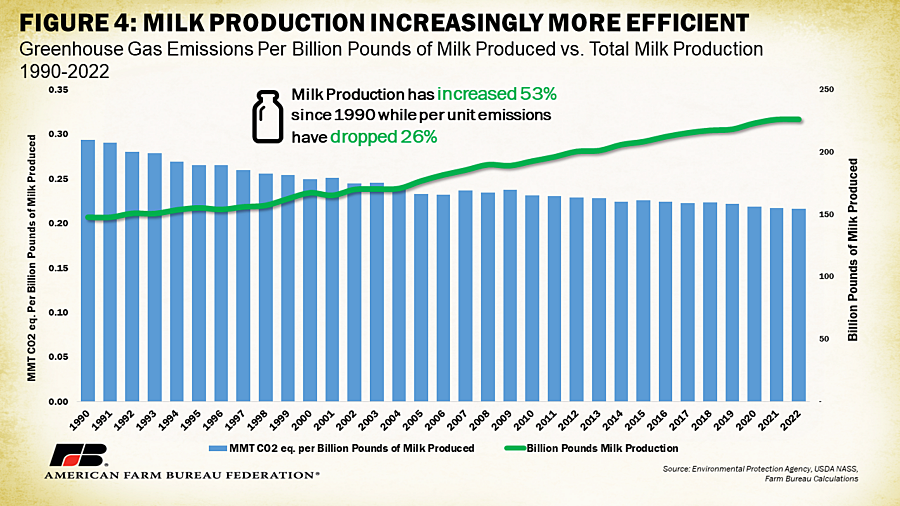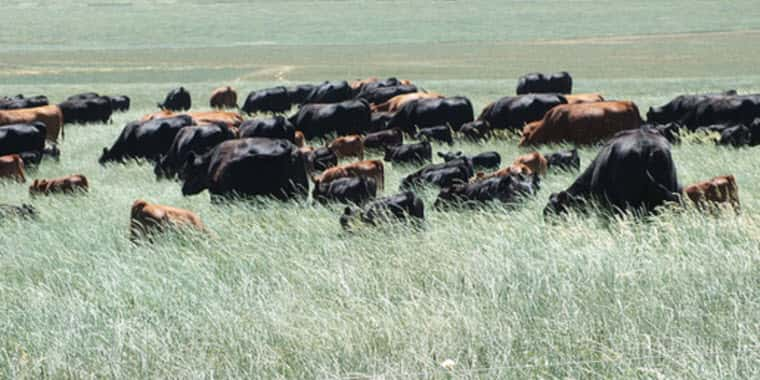America’s farmers and ranchers are leading the way in greenhouse gas emission reduction through voluntary conservation efforts and market-based incentives.The Environmental Protection Agency (EPA) released the Inventory of U.S. Greenhouse Gas Emissions and Sinks: 1990-2022. The report shows American agriculture reduced emissions by almost 2% from 2021 to 2022, the largest decrease of any economic sector.

American Farm Bureau Federation economists analyzed the data in the latest Market Intel, noting, “U.S. agriculture represents just under 10% of total U.S. emissions when compared to other economic sectors… By EPA’s own methodology, emissions from agriculture totaled 634 million metric tons in CO2 equivalents, or 9.99% of all U.S. emissions, during 2022. This represents a decrease of 1.8%, or 12 million metric tons, from 2021… 2022 marks the lowest U.S. agricultural greenhouse gas emissions since 2012.”
The largest emissions source was the transportation sector, representing 28% of total emissions and totaling 1.8 billion metric tons. Transportation emissions declined 0.2%, or 4 million metric tons, from the prior year. Following transportation, electricity generation represented 25% of total emissions at 1.57 billion metric tons. Emissions from the electric power industry were down 0.4% from 2021 after a 6.9% increase between 2020 and 2021.
The industrial sector, which includes the production of iron and steel, as well as other input materials like cement, represented 23% of all emissions at 1.45 billion metric tons. Emissions from the industrial sector declined 0.2% compared to 2020. The commercial and residential sectors and U.S. territories represented 14% of all U.S. emissions, increasing a significant 4.8% compared to 2021. Emissions in this category are heavily linked to building-related activities such as heating, cooling and cooking.

“The latest numbers demonstrate farmers’ and ranchers’ commitment to growing the food and fiber America’s families rely on while improving the land, air and water, a benefit to the farm and the climate,” said AFBF President Zippy Duvall. “The drop in agricultural emissions highlights the success and importance of voluntary and market-based programs that support farmer efforts in sustainable agriculture practices. The latest numbers should also serve as inspiration to lawmakers who can build on this progress by passing a farm bill, which not only provides a safety net for farmers, but also helps them meet sustainability goals.”
Other highlights specific to the agricultural sector in the Market Intel include:
- 12-million-metric-ton reduction in greenhouse gas emissions;
- 2.1% reduction in livestock GHG emissions;
- 1.7% reduction in crop cultivation emissions; and
- 1.2% reduction in fuel combustion emissions.
A comparison of 2022 emissions to 1990 emissions shows U.S. agricultural emissions have increased by 6.4%. However, that’s not the full story. Productivity is increasing, as it must to keep feeding a growing global population, and emissions are on the decline relative to this productivity and population increase. Innovation and advancements in technology have allowed farmers and ranchers to increase their productivity while using the same amount of inputs.
Compared to 1948, farmers and ranchers are producing nearly three times more in output per unit of input they use, according to USDA’s-Economic Research Service. Acreage in operation has declined by 323 million acres since 1950, almost double the size of Texas. This means that farmers and ranchers continue to produce more using fewer resources and the additional decrease in agricultural emissions shows that voluntary, market-based incentives are helping farmers and ranchers accomplish this.
Consider two examples: milk production and red meat production, which includes cattle, swine and sheep raised for meat. Between 1990 and 2022, U.S. dairy farmers have increased milk output by 53%, going from 148 billion pounds to 226 billion pounds to meet increasing global demand for products like cheese, butter and dairy powders. During this same timeframe, emissions from enteric fermentation from dairy cattle per billion pounds of milk produced have dropped 26%, going from 293 million metric tons to 216 million metric tons per billion pounds of milk produced.
Similarly, global demand for red meat products continues to rise and farmers have met the challenge in a more efficient manner. In 1990, U.S. farmers produced 39 billion pounds of red meat; this grew 44% to 55.6 billion pounds in 2022. In the same timeframe, greenhouse gas emissions from enteric fermentation from beef cattle dropped 28%, going from 3.5 million metric tons to 2.5 million metric tons per billion pounds produced. This shows how livestock producers have embraced technological innovation and production practices that increase output while reducing associated emissions.


Read the full Market Intel here.


